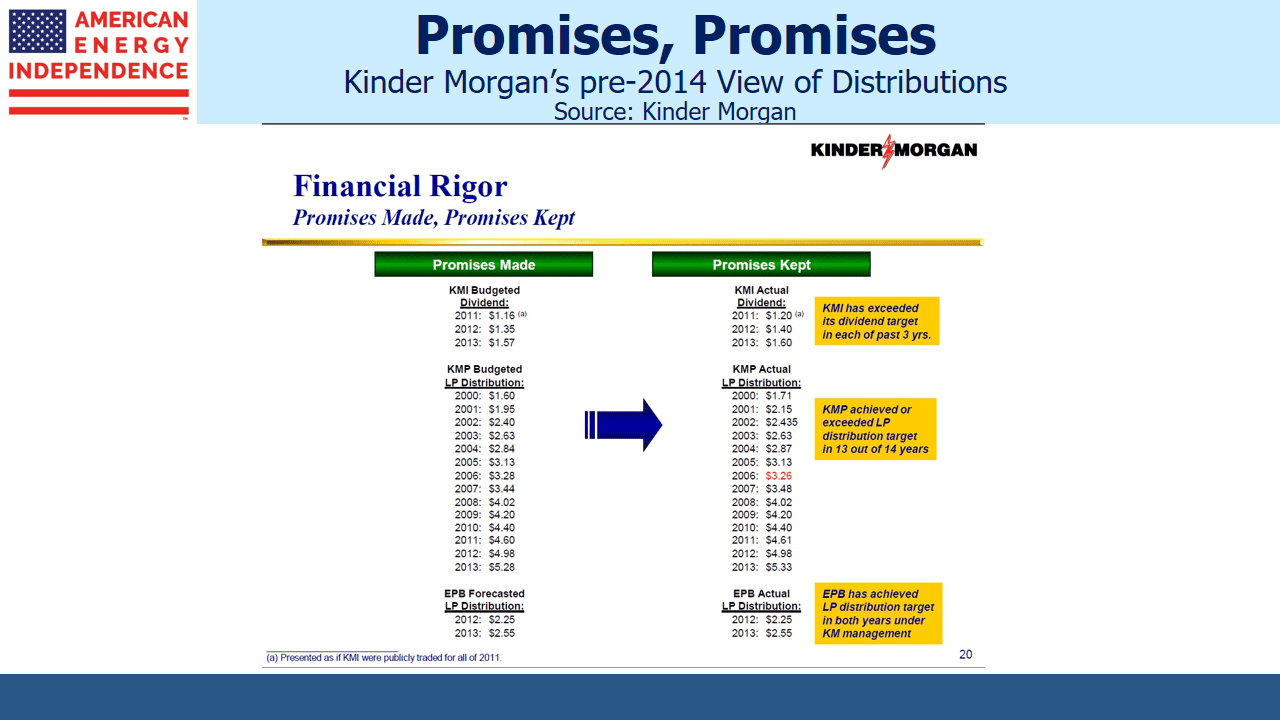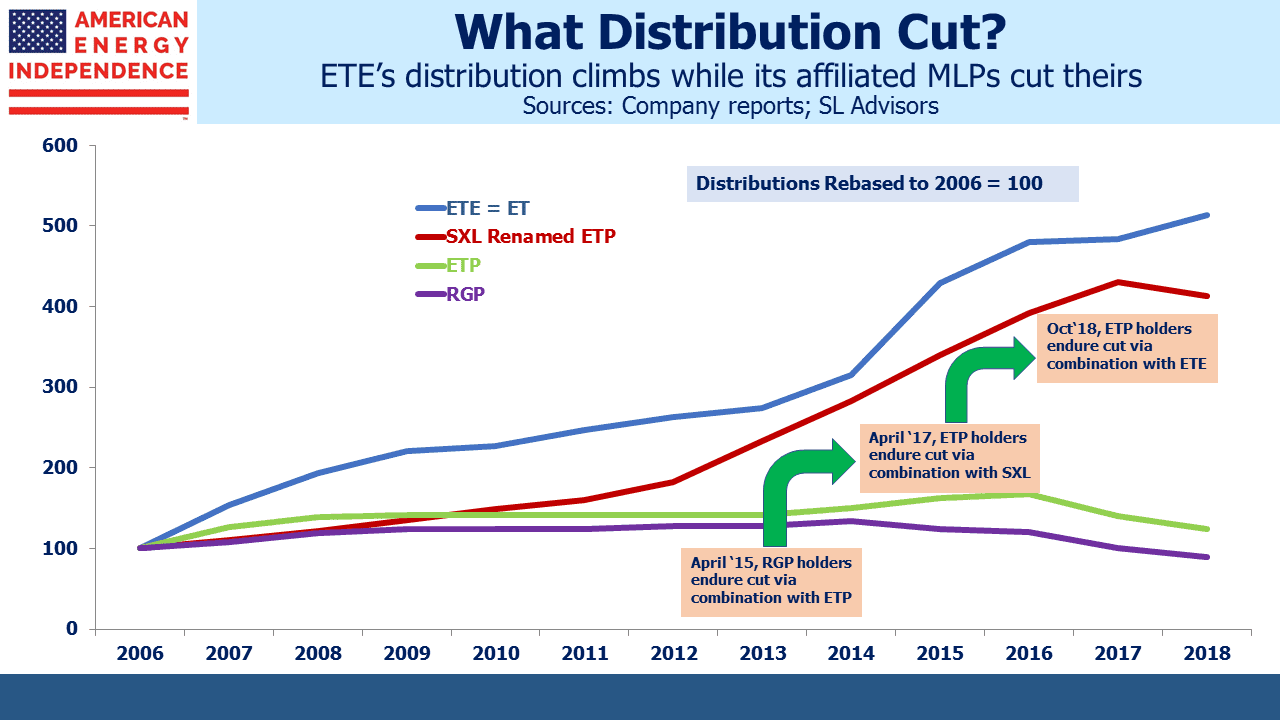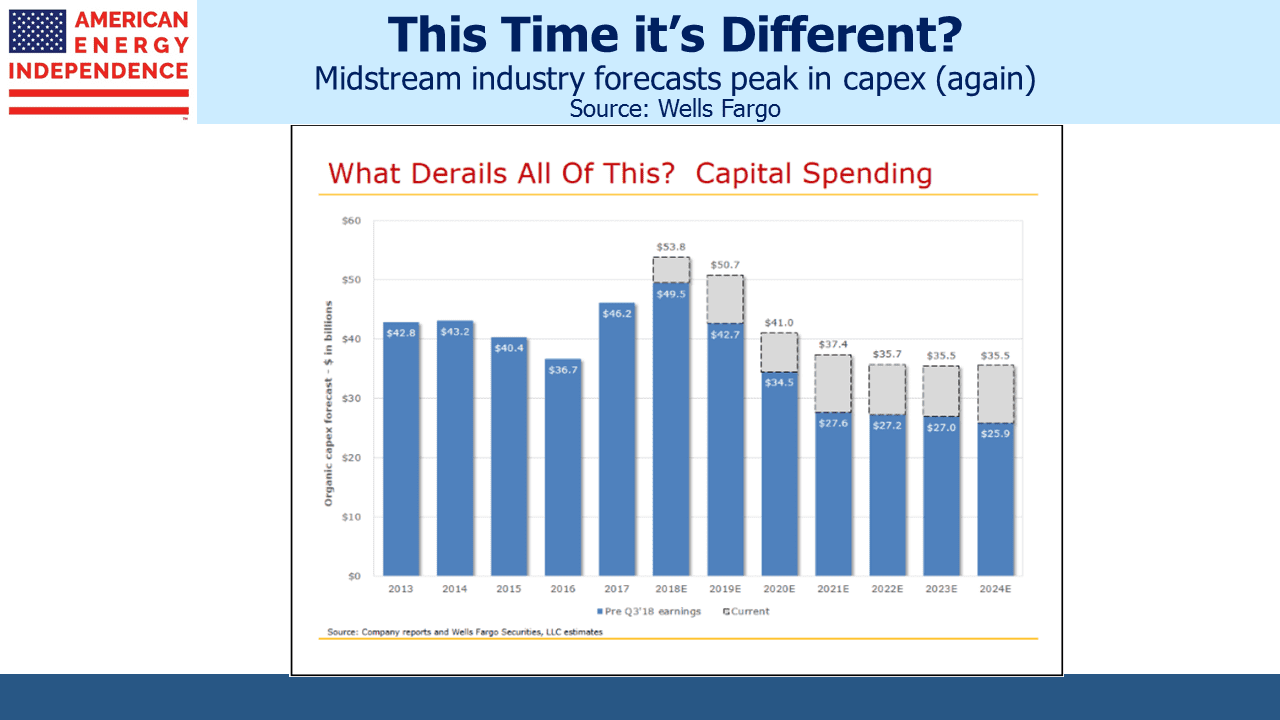2018 Lessons From The Pipeline Sector
Blog pageviews and comments help us gauge how relevant our topics are. Writing is more enjoyable when readers engage. This blog gets reposted across many websites, including Seeking Alpha and Forbes.com. The feedback from subscribers often leads to a useful dialog and informs later choice of topics. Below are the themes that resonated in 2018.
The name Rich Kinder strikes a raw nerve with many. Kinder Morgan: Still Paying For Broken Promises revealed the depth of feeling among many investors. This is because Kinder Morgan (KMI) began the trend towards “simplification”, which came to mean distribution cuts and an adverse tax outcome. To get a sense of the betrayal felt by some, peruse the comments on the blog post on Seeking Alpha where readers can let rip in a mostly un-moderated forum. It becomes clear that cutting payouts has severely damaged appetite for the sector, something we realized through this type of feedback.
A similar post examined how Energy Transfer (ET) had lowered payouts for certain classes of investor, (see Energy Transfer: Cutting Your Payout Not Mine) and drew an even bigger response (272 comments). ET CEO Kelcy Warren is a controversial figure. Our post showed that while original Energy Transfer Equity investors had avoided distribution cuts, holders of Energy Transfer Partners, Sunoco Logistics and Regency Partners hadn’t fared so well.
Kelcy Warren inspired our most colorful graphic in August, when he said, “A monkey could make money in this business right now.” (see Running Pipelines Is Easy). ET’s stock has lost a quarter of its value since then, even though their financial performance has justified his comments.
Last year was a testing one for those convinced the Shale Revolution should generate investment profits. In Valuing MLPs Privately; Enterprise Products Partners we laid out how a private equity investor might value the biggest publicly traded MLP. It wasn’t controversial, but many readers communicated their appreciation at this type of analysis.
The problem for the sector has always been balancing high cash distributions with financing growth projects. We think current valuations focus too much on Free Cash Flow (FCF) without giving credit to Distributable Cash Flow (DCF). FCF is after growth capex, while DCF is before. We illustrated this with a short video (see Valuing Pipelines Like Real Estate).
Early in the year we wrote several blog posts highlighting the tax drag faced by most MLP-dedicated funds. Because they pay Federal corporate taxes on investment profits, 2018’s bear market didn’t expose their flawed structure the way a bull market will. We won’t repeat the argument here, but it’s laid out in MLP Funds Made for Uncle Sam.
A related topic we covered several times was the conundrum facing MLP-only funds, given that many big MLPs have converted to regular corporations. MLP-only funds can no longer claim to provide broad sector exposure, since they omit most of the biggest North American pipeline companies. But the funds themselves can’t easily broaden their holdings beyond MLPs, which creates some uncertainty for their investors. We explained why in Are MLPs Going Away? and The Alerian Problem.
We returned to the tension between using cash for growth versus distributions in Buybacks: Why Pipeline Companies Should Invest in Themselves. The industry continues to reinvest more cash in new infrastructure than is justified by stock prices. In many cases, share repurchases offer a better and more certain return than a new pipeline. Trade journals are full of breathless commentary on the need for more export facilities, more pipelines, more everything. It’s not pleasant reading for an investor, but this is the world inhabited by industry executives. More mention of IRR would be welcome. Pipeline investors are hoping that the Wells Fargo chart showing lower capex in the future will, finally, be accurate.
Fortunately, there are signs of better financial discipline. Leverage continues to drop and dividend coverage is improving, which will support a 6-8% increase in dividends on the American Energy Independence Index in 2019. As the year unfolds, we expect investors to cheer a long overdue improvement in returns.
We are invested in ET and KMI.
SL Advisors is the sub-advisor to the Catalyst MLP & Infrastructure Fund. To learn more about the Fund, please click here.
SL Advisors is also the advisor to an ETF (USAIETF.com).
Important Disclosures
The information provided is for informational purposes only and investors should determine for themselves whether a particular service, security or product is suitable for their investment needs. The information contained herein is not complete, may not be current, is subject to change, and is subject to, and qualified in its entirety by, the more complete disclosures, risk factors and other terms that are contained in the disclosure, prospectus, and offering. Certain information herein has been obtained from third party sources and, although believed to be reliable, has not been independently verified and its accuracy or completeness cannot be guaranteed. No representation is made with respect to the accuracy, completeness or timeliness of this information. Nothing provided on this site constitutes tax advice. Individuals should seek the advice of their own tax advisor for specific information regarding tax consequences of investments. Investments in securities entail risk and are not suitable for all investors. This site is not a recommendation nor an offer to sell (or solicitation of an offer to buy) securities in the United States or in any other jurisdiction.
References to indexes and benchmarks are hypothetical illustrations of aggregate returns and do not reflect the performance of any actual investment. Investors cannot invest in an index and do not reflect the deduction of the advisor’s fees or other trading expenses. There can be no assurance that current investments will be profitable. Actual realized returns will depend on, among other factors, the value of assets and market conditions at the time of disposition, any related transaction costs, and the timing of the purchase. Indexes and benchmarks may not directly correlate or only partially relate to portfolios managed by SL Advisors as they have different underlying investments and may use different strategies or have different objectives than portfolios managed by SL Advisors (e.g. The Alerian index is a group MLP securities in the oil and gas industries. Portfolios may not include the same investments that are included in the Alerian Index. The S & P Index does not directly relate to investment strategies managed by SL Advisers.)
This site may contain forward-looking statements relating to the objectives, opportunities, and the future performance of the U.S. market generally. Forward-looking statements may be identified by the use of such words as; “believe,” “expect,” “anticipate,” “should,” “planned,” “estimated,” “potential” and other similar terms. Examples of forward-looking statements include, but are not limited to, estimates with respect to financial condition, results of operations, and success or lack of success of any particular investment strategy. All are subject to various factors, including, but not limited to general and local economic conditions, changing levels of competition within certain industries and markets, changes in interest rates, changes in legislation or regulation, and other economic, competitive, governmental, regulatory and technological factors affecting a portfolio’s operations that could cause actual results to differ materially from projected results. Such statements are forward-looking in nature and involves a number of known and unknown risks, uncertainties and other factors, and accordingly, actual results may differ materially from those reflected or contemplated in such forward-looking statements. Prospective investors are cautioned not to place undue reliance on any forward-looking statements or examples. None of SL Advisors LLC or any of its affiliates or principals nor any other individual or entity assumes any obligation to update any forward-looking statements as a result of new information, subsequent events or any other circumstances. All statements made herein speak only as of the date that they were made. r
Certain hyperlinks or referenced websites on the Site, if any, are for your convenience and forward you to third parties’ websites, which generally are recognized by their top level domain name. Any descriptions of, references to, or links to other products, publications or services does not constitute an endorsement, authorization, sponsorship by or affiliation with SL Advisors LLC with respect to any linked site or its sponsor, unless expressly stated by SL Advisors LLC. Any such information, products or sites have not necessarily been reviewed by SL Advisors LLC and are provided or maintained by third parties over whom SL Advisors LLC exercise no control. SL Advisors LLC expressly disclaim any responsibility for the content, the accuracy of the information, and/or quality of products or services provided by or advertised on these third-party sites.
All investment strategies have the potential for profit or loss. Different types of investments involve varying degrees of risk, and there can be no assurance that any specific investment will be suitable or profitable for a client’s investment portfolio.
Past performance of the American Energy Independence Index is not indicative of future returns.





We should not want railroads and tractor trailers carrying these dangerous fossil fuels. We should bury them in pipelines with sophisticated sensors that automatically shut-off the pipeline AND close valves along the pipeline to limit what still will be a tragic accidents. The greatest nation in the world, with the biggest supply of energy, should lead in making transportation, from well to home and vehicle, as safe as possible.